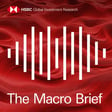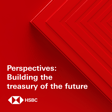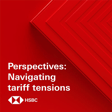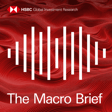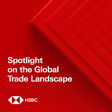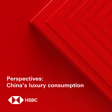Become a Creator today!Start creating today - Share your story with the world!
Start for free
00:00:00
00:00:01

The Macro Viewpoint - EM Sentiment Survey, energy shock, Europe’s COVID-19 wave and India update
In this edition we assess the results of HSBC's sixth survey of EM institutional investors, the economic impact of high energy prices, the new wave of Winter COVID-19 infections spreading across Europe and India’s growth prospects. Disclaimer.
To stay connected and to access free to view reports and videos from HSBC Global Research click here.
Hosted on Acast. See acast.com/privacy for more information.
Transcript
Introduction to HSBC Podcast
00:00:00
Speaker
This is HSBC Global Viewpoint, your window into the thinking, trends and issues shaping global banking and markets.
00:00:09
Speaker
Join us as we hear from industry leaders and HSBC experts on the latest insights and opportunities for your business.
00:00:17
Speaker
Thank you for listening.
Bearish Sentiment in Emerging Markets
00:00:22
Speaker
You're listening to the HSBC Global Research Macro Viewpoint, our weekly review of the key reports from our team of economists and strategists across the globe.
00:00:33
Speaker
Coming up today, we discuss why emerging market investors are turning more bearish amid mounting concerns over the global economy.
00:00:39
Speaker
We also examine the economic impact of high energy prices, the new wave of winter COVID-19 infections spreading across Europe and India's growth prospects.
00:00:49
Speaker
This podcast was recorded on Thursday, the 25th of November 2021.
00:00:52
Speaker
Our full disclosures and disclaimers can be found in the link attached to the podcast.
00:00:59
Speaker
Hello, I'm Chris Brown-Hunes.
00:01:01
Speaker
And I'm Piers Butler.
00:01:03
Speaker
This week, we released the sixth edition of the HSBC Emerging Markets Sentiment Survey.
00:01:09
Speaker
The survey canvests the opinions of 120 investors from 115 institutions with over half a trillion dollars of assets under management in emerging markets.
00:01:19
Speaker
Murat Ulgan is Global Head of Emerging Markets Research, and he joins us now.
Market Volatility and Economic Concerns
00:01:24
Speaker
Murat, what's the key takeaway from our latest survey?
00:01:27
Speaker
The key takeaway is the big shift in sentiment.
00:01:29
Speaker
Now, 27% of the investors surveyed are actually bearish on emerging markets outlook prospects over the next three months, which has tripled from the previous survey in July.
00:01:39
Speaker
And also, the number of investors who are bullish has come down from 40% to 27%.
00:01:45
Speaker
So it's a big shift where the consensus was mostly neutral on emerging markets only three months ago.
00:01:52
Speaker
And you can see this shift also in cash levels.
00:01:54
Speaker
They've already been quite high, but they kept going higher.
00:01:58
Speaker
Now the share of respondents who have more than 5% cash in their portfolio as a percent of assets under management is actually even higher with the survey.
00:02:06
Speaker
To what do you attribute this change in sentiment?
00:02:08
Speaker
Well, the survey period has coincided with an episode where financial market volatility was quite high.
00:02:14
Speaker
There are continued worries about COVID, energy prices spiked, inflation was going higher, and obviously emerging market center banks were tightening monetary policy and hiking interest rates.
00:02:26
Speaker
And when you also ask investors about their key risk perception, they do worry about Fed and developed market tightening.
00:02:33
Speaker
And then the joint second worry is China's slowdown in property market concerns there, as well as higher than expected inflation across emerging markets.
00:02:42
Speaker
So interestingly, COVID is only ranking fourth at the moment.
00:02:45
Speaker
But overall, it's the perception that, you know, emerging markets have downside growth risk in their economies and upside inflation risk, probably making investors more cautious.
00:02:54
Speaker
You say cautious, and in fact, the title of your piece is Cautious Yet Engaged.
Investor Strategies in Volatile Times
00:02:59
Speaker
What do you mean by engaged?
00:03:00
Speaker
Yeah, that's quite interesting.
00:03:01
Speaker
I mean, yes, the cash levels have gone up, but at the same time, we ask investors, how are you intended to use that cash?
00:03:07
Speaker
Are you going to increase it, decrease it, or keep all the same?
00:03:10
Speaker
Now, more investors are keen to deploy that cash.
00:03:14
Speaker
And also every survey we ask about at-risk appetite at the current juncture with zero being no intention to take any risk in EM and 10 full EM risk.
00:03:25
Speaker
And the weighted average score has actually gone up modestly from 6.2 to 6.6 in the survey.
00:03:31
Speaker
So it tells you that investors are cautious with the fundamental backdrop, but they can't remain impervious to cheap valuations and low positioning in emerging markets.
00:03:41
Speaker
And which regions and asset classes are they favouring at the
Regional Preferences and Currency Caution
00:03:44
Speaker
moment?
00:03:44
Speaker
So when there is much uncertainty, you usually see a behaviour where investors turn back to Asia's relative safety.
00:03:51
Speaker
And that has been the case where the overweight weighting has gone up for Asia.
00:03:54
Speaker
But the interesting takeaway for this survey is Central Eastern Europe, a sort of a rising star in terms of regional preference.
00:04:02
Speaker
Across all asset classes, the net sentiment is positive.
00:04:05
Speaker
And one way to explain this is, Central Eastern Europe is a different universe.
00:04:10
Speaker
The worry is not stagflation there.
00:04:11
Speaker
The worry is classical overheating, where growth is actually pretty good, but inflation is also high.
00:04:17
Speaker
But then there is probably some confidence by investors that policymakers will eventually re-in.
00:04:22
Speaker
So, Central Eastern Europe is the key region in the survey, which has risen in ranking.
00:04:27
Speaker
And what about asset classes?
00:04:29
Speaker
Well, investors are more cautious on FX because those who are expecting depreciation of emerging market currencies more than doubled in the survey compared to the previous one.
00:04:39
Speaker
For fixed income, the preference is for external debt, although there's a marked increase in the number who, you know, don't prefer, you know, either local market debt or external debt.
00:04:49
Speaker
On equities, only one third of investors are looking for equity markets to go higher in EM over the next three months.
00:04:56
Speaker
and about the same low proportion expecting emerging market equities to outperform developed markets.
Importance of Climate Finance for Emerging Markets
00:05:01
Speaker
And finally, Murat, are there any takeaways for ESG investors?
00:05:04
Speaker
Yes, ESG engagement still remains fairly high at about 45% unchanged from July and the ranking of care risk hasn't changed.
00:05:13
Speaker
But this survey has coincided with COP26 summit of climate negotiations and will ask questions
00:05:20
Speaker
about which one is the most pressing issue for emerging markets during this COP26 summit.
00:05:25
Speaker
And climate finance came out top, especially the need for developed markets to help emerging markets finance their transition strategies was an important takeaway on the SG side.
00:05:36
Speaker
All right.
00:05:36
Speaker
Thank you very much indeed for that summary.
00:05:38
Speaker
Thank you, Chris.
Impact of Rising Energy Prices
00:05:41
Speaker
Rising energy prices have just forced President Biden, along with other Asian and European countries, to release some of their strategic oil reserves in a bid to lower oil prices and inflation.
00:05:51
Speaker
Janet Henry, global chief economist, has been looking at what could happen to the world economy if prices stay elevated or even resume rising.
00:05:58
Speaker
Janet, you call your report energy shock.
00:06:01
Speaker
In what sense?
00:06:02
Speaker
Because energy prices have been rising across the board, well, certainly across all fossil fuels for some time.
00:06:08
Speaker
As you said in your intro, President Biden, along with other governments, has released some of its strategic oil reserves or plans to over the course of the next few months.
00:06:18
Speaker
The oil price is actually, yes, high, but nowhere near where it was back in 2011, 2008,
00:06:26
Speaker
And then in real terms, only half where it was in the 1970s.
00:06:30
Speaker
But we have already seen coal prices, gas prices, as well as oil prices rising across the board for some time.
00:06:39
Speaker
And of course, this is happening at a time when there are a number of other bottlenecks around the world.
00:06:44
Speaker
And the cost of living squeeze is becoming an increasingly political issue.
00:06:49
Speaker
And what impact is this having on inflation?
00:06:51
Speaker
Well, we have obviously seen inflation gradually rise globally, and now energy is adding quite a lot.
00:06:59
Speaker
We've seen it across the board in producer price inflation, even in the likes of Japan.
00:07:03
Speaker
where producer price inflation is running at about 8% in China, it's running at about 14%.
00:07:10
Speaker
But the impact on consumer prices is actually much more variable around the world, depending on how much of the basket of goods is on energy, also depends on what the tax structure and indeed the extent to which governments intervene with subsidies and such like.
00:07:28
Speaker
And that's why we're seeing something quite different around the world.
00:07:32
Speaker
In Asia, inflation has risen a lot less, not just in terms of energy price inflation, but actually other areas of inflation.
00:07:39
Speaker
They have not had the same consumer recovery that most of the rest of the world has had, where fiscal policy has been much more generous.
00:07:49
Speaker
So in other emerging regions like Latin America, where energy is not necessarily the biggest driver, but may become so, food prices and other durable goods are pushing up inflation.
00:08:00
Speaker
And in the US and Europe, energy is adding to inflation.
00:08:04
Speaker
But in the US, the inflation story is increasingly broad, whereas most of the spike in inflation in Europe has been driven primarily by energy, gas prices as well as oil prices.
00:08:17
Speaker
And is growth being affected?
00:08:19
Speaker
The difficulty with trying to identify exactly what the growth impact is, is that there is so much else going on.
00:08:27
Speaker
COVID restrictions are toing and froing around the world.
00:08:31
Speaker
They're being implemented and then reopening.
00:08:34
Speaker
And that's having quite a big impact in terms of the volatility of growth rates coming through.
00:08:39
Speaker
What we can see now, even if we look at the US, is that incomes are still rising, but inflation is rising more quickly.
00:08:49
Speaker
So over the last couple of months, real incomes in September and October in the US have actually fallen.
00:08:56
Speaker
But we also know that the longer energy prices stay high, the more that we will see further increases
00:09:03
Speaker
That will keep inflation high.
00:09:05
Speaker
Real incomes may actually shrink in some countries in 2022, but we also know they've accumulated a lot of savings.
00:09:13
Speaker
In the US, accumulated savings account for about 18% of consumer spending, but we also know there's an income distribution factor.
00:09:23
Speaker
And I think that's the other complicating factor.
00:09:25
Speaker
If we look at the lowest income people, they spend twice as much on energy as the highest income,
00:09:30
Speaker
And it's the highest income that have actually got the savings.
00:09:34
Speaker
And which countries are the winners in this situation and which are the losers?
00:09:37
Speaker
Well, it's a relative story.
00:09:39
Speaker
Ultimately, an oil price rise tends to mean that there is a redistribution of income away from oil consuming countries to oil producing countries.
00:09:50
Speaker
countries so there will be growing vulnerabilities in consuming countries, particularly as they can be intervening there will be some countries where actually the public finances.
00:10:00
Speaker
will be hit as they continue to subsidize some of these fuels, but in the oil producing countries and i'm thinking in particular.
00:10:08
Speaker
some of the economies in the Gulf, actually, for some of those that were actually quite prudent in 2020 and really didn't deliver much in the way of fiscal stimulus, the likes of Saudi Arabia even had fiscal consolidation.
00:10:22
Speaker
These are windfall gains.
00:10:24
Speaker
And actually, with oil prices at these levels, they're going to be moving back into budget balances in a number of countries.
00:10:31
Speaker
So relatively speaking, they are the relative winners.
00:10:35
Speaker
Janet, thank you very
COVID-19 and European Economic Slowdown
00:10:36
Speaker
much for that summary.
00:10:37
Speaker
Thank you, Chris.
00:10:40
Speaker
Europe's winter wave of COVID-19 is gathering pace with case numbers across the continent surging.
00:10:46
Speaker
Liz Martins, senior UK economist, joins us now to talk through the latest data.
00:10:52
Speaker
Liz, how bad have case numbers gone?
00:10:54
Speaker
Well, unfortunately, there is a winter wave of COVID-19 accelerating through Europe.
00:10:59
Speaker
So the key measure we look at in our COVID-19 tracker is the big four plus UK, so France, Germany, Spain, Italy and UK.
00:11:07
Speaker
And the number of cases in those five countries was up 42 percent on the week since we last published our tracker across Europe.
00:11:15
Speaker
I guess the hotspots at the moment are Germany, Austria, Belgium, the Netherlands.
00:11:19
Speaker
You know, for most of these countries, these numbers are higher than they've ever been.
00:11:23
Speaker
at any point during the pandemic.
00:11:25
Speaker
Other countries, the case numbers are lower, France, Spain, Italy, but they are starting to pick up as well.
00:11:30
Speaker
So, you know, clearly, it's not as bad as it has been in previous waves in terms of the vaccine is stopping death rates, hospitalisation rates, getting to anything like what they were maybe last winter.
00:11:41
Speaker
But clearly, the case numbers are picking up sharply.
00:11:44
Speaker
How are governments responding?
00:11:46
Speaker
Austria is the only government in Europe so far to have imposed a full lockdown.
00:11:51
Speaker
Elsewhere across mainland Europe, you're seeing governments kind of beefing up their vaccine passport rules.
00:11:56
Speaker
So
00:11:57
Speaker
for example, to go out to restaurants, cinema, social occasions.
00:12:02
Speaker
There's more requirements to prove that you've kind of tested negative for COVID or you've been vaccinated and so on and so forth.
00:12:09
Speaker
It seems that governments are keen to avoid full lockdowns this time around.
00:12:14
Speaker
What's really noteworthy is the difference across the channel in the UK, where the government is pushing ahead with
00:12:21
Speaker
Plan A and in fact the English government doesn't even have a requirement for mandatory mask wearing, it doesn't even recommend working from home.
00:12:29
Speaker
even though case numbers in the UK are relatively elevated.
00:12:34
Speaker
And that's for a few reasons.
00:12:36
Speaker
I think, one, UK case numbers have been elevated for quite a long time.
00:12:41
Speaker
You know, we've averaged 35,000 cases a day since the 1st of July.
00:12:44
Speaker
So I think perhaps the UK population on that basis has a bit more natural immunity.
00:12:50
Speaker
There's some suggestion that the AstraZeneca vaccine that the UK relied upon
00:12:56
Speaker
may have a more durable effect than the mRNA vaccines that Europe used predominantly and that may support lower rate hospitalisation here in the UK.
00:13:09
Speaker
But yeah, it does seem that it's quite a different approach and the UK government is hoping not to have to do very much at all.
00:13:17
Speaker
And how is all of this being reflected in the latest economic data?
00:13:22
Speaker
Well, I think the data we have so far reflecting the pickup in COVID cases is really just the mobility data.
00:13:27
Speaker
And we have seen a downturn in mobility across Europe and the UK.
00:13:32
Speaker
In terms of the economic data more generally, though, I think we have seen a slowdown since the summer in momentum.
00:13:38
Speaker
A lot of that is due to kind of global supply chain issues and shortages.
00:13:43
Speaker
The PMI surveys for November were a little bit more encouraging in that regard.
00:13:47
Speaker
We generally saw the European headline numbers come back up.
00:13:51
Speaker
And the supply side indicators look a little bit more healthy.
00:13:55
Speaker
And apart from that, it kind of varies by country.
00:13:57
Speaker
You know, if we look at the German IFO survey, that's been weak for a number of months, whereas French business confidence is holding up much better.
00:14:05
Speaker
And similarly, if we look to consumers in the eurozone, it's turning down amidst these kind of high levels of COVID.
00:14:11
Speaker
And in the UK, it's just picked back up in the last release.
00:14:14
Speaker
So there is some variation between countries.
00:14:17
Speaker
But more broadly speaking, I think we have had a slowdown since the summer, which was perhaps inevitable given the pace of growth leading up to the summer.
00:14:24
Speaker
And, you know, plenty of headwinds still exist.
00:14:27
Speaker
Liz, thanks very much.
00:14:28
Speaker
Thank you.
Domestic Demand and Economic Growth Potential
00:14:32
Speaker
In contrast to those high case numbers in Europe, COVID-19 infections in India remain relatively low.
00:14:37
Speaker
Pranjal Bhandari, chief India economist, has been looking at the key drivers of the country's economic growth as we head towards 2022.
00:14:45
Speaker
She joins us now from Mumbai.
00:14:46
Speaker
Pranjal, is rural growth likely to hold up?
00:14:49
Speaker
That's a great question.
00:14:50
Speaker
Rural demand was a source of stability through most of the pandemic period, but in the last few months, it seems to have slowed quite a bit.
00:14:58
Speaker
Some of the social welfare spending of the government has weakened, rains have been volatile, rural inflation has risen.
00:15:05
Speaker
So all of this is slowing rural demand.
00:15:08
Speaker
But looking ahead, things could change, things could improve.
00:15:11
Speaker
And I think the main area is construction activity.
00:15:15
Speaker
Over the last decade or two, rural Indians have diversified into non-agricultural activities, for instance, construction.
00:15:23
Speaker
Construction is heavily dominated by real estate and there is a picking up demand for real estate as people who've been stuck in their houses for two years are trying to improve their houses.
00:15:34
Speaker
There's a big demand for real estate construction.
00:15:36
Speaker
And if that really picks up, as some data is showing, that could improve rural income and rural demand going forward.
00:15:43
Speaker
If the rich are spending more, is this trickling down?
00:15:46
Speaker
Yeah, so look, it's sort of understood now that inequality has risen through the pandemic period in India.
00:15:53
Speaker
But there is also a sense that the rich are spending and hopefully this will trickle down to the bottom of the pyramid.
00:16:00
Speaker
Unfortunately, the trickle down has been pretty slow so far.
00:16:04
Speaker
And the big reason is that even as the rich are spending,
00:16:08
Speaker
we are spending quite a lot on imported goods.
00:16:11
Speaker
So just to put some numbers, the domestic production of consumer goods is still 6% below pre-pandemic levels.
00:16:18
Speaker
But the imports of the same consumer goods are 36% above pre-pandemic levels.
00:16:23
Speaker
So it's imports that is dominating the consumption basket and therefore the trickle down has been weak.
00:16:30
Speaker
But looking ahead, if we do see a pivot from goods demand to services demand as vaccination rates pick up, then the trickle down could improve.
00:16:40
Speaker
simply because services are more domestically produced, you know, think health services, education services, compared to goods.
00:16:48
Speaker
And once the rich start demanding more of that, the trickle down could improve and that would be good for GDP growth.
Growth Drivers and Inflation Challenges
00:16:55
Speaker
So what will drive growth in 2022?
00:16:57
Speaker
Yeah, so look, in the next couple of months, I think pent-up services demand is going to be one of the biggest drivers of GDP growth.
00:17:04
Speaker
But once that's satiated, I think India will have to look for new drivers.
00:17:09
Speaker
Thankfully, there are a few drivers out there.
00:17:12
Speaker
For instance, high-skill exports have been doing very well.
00:17:16
Speaker
Think IT exports, automobiles, drugs and pharmaceuticals, mobile phones.
00:17:22
Speaker
All of these exports have been doing well.
00:17:24
Speaker
Another new sector that is coming along well is the whole tech startup ecosystem, digital firms going very rapidly.
00:17:32
Speaker
And then there are some new reforms that the government is pursuing, for example, asset monetization, the creation of bad banks.
00:17:40
Speaker
So all of these are exciting things that could drive both in 2022, but at the same time, the country will also have to live with some of the scars that the pandemic is likely to leave behind.
00:17:50
Speaker
And the biggest scar
00:17:51
Speaker
is the rising cost of economic inequality.
00:17:56
Speaker
Our sense is that first potential growth could actually drop from 6% pre-pandemic to 5.5%, but hopefully with the right government reforms, it could pick back up over time.
00:18:08
Speaker
And how high could inflation climb?
00:18:10
Speaker
So we worry about inflation for three reasons.
00:18:12
Speaker
One is energy prices.
00:18:14
Speaker
They make up 8% of the inflation basket.
00:18:17
Speaker
And at current levels, they could add one percentage point to India's inflation.
00:18:21
Speaker
The second is manufacturing margins.
00:18:24
Speaker
With all of these input prices rising, manufacturing margins are at a seven-year low.
00:18:29
Speaker
If manufacturers pass on some of these cost increases to consumers,
00:18:34
Speaker
That could add to inflation.
00:18:36
Speaker
And the final one is services demand.
00:18:38
Speaker
Whenever services demand rise rapidly, it does become inflationary because, you know, services are homegrown.
00:18:45
Speaker
You know, you can't import it and you can't sort of import the price pressures off.
00:18:51
Speaker
So putting all of this together, we think inflation could cross 6%.
00:18:56
Speaker
in the next couple of months, starting December, you know, until April.
00:19:00
Speaker
And that is higher than RBI's upper tolerance limit.
00:19:04
Speaker
And that would make RBI, you know, try to normalize monetary policy a little more aggressively.
00:19:10
Speaker
Pranjal, thanks very much for your time.
00:19:12
Speaker
Great to be here.
Conclusion and Acknowledgments
00:19:16
Speaker
So that's all from us today.
00:19:17
Speaker
Thank you to our guests, Murad Ulgan, Janet Henry, Liz Martins, and Pranjal Bhandari.
00:19:22
Speaker
From all of us here, thanks for listening.
00:19:24
Speaker
We'll be back again next week.
00:19:31
Speaker
Thank you for listening today.
00:19:32
Speaker
This has been HSBC Global Viewpoint Banking and Markets.
00:19:37
Speaker
For more information about anything you heard in this podcast or to learn about HSBC's global services and offerings, please visit gbm.hsbc.com.
